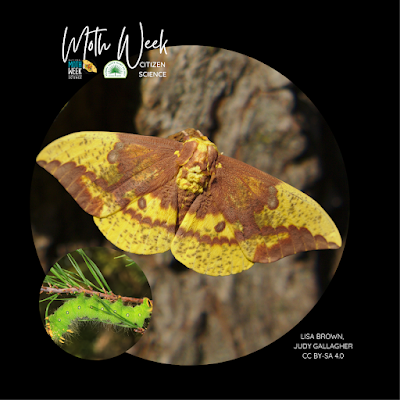National Moth Week 2023 - The Imperial Moth
The Imperial Moth, Eacles imperialis, is a member of the family Saturniidae and subfamily Ceratocampinae. The subfamily has many genera and is characterized by the antennae of males that are quadripectenate (featherlike, with each branch split into two parts) at the basal half or two-thirds of the way up the antenna, with the outer portion simple (not featherlike). Eacles imperialis has a very wide distribution ranging from eastern portions of southern Canada to Argentina.
Imperial moths are classified in a section of the giant silkworm family called the royal moths- all of which are brightly colored and native to the New World. Royal moths are robust bodied with lobed wings and hair-like scales. The imperial moth is yellow with spots, lines and splotches of light to dark brown.
Imperial moths emerge from the soil in late spring to mate and then die. An adult Imperial moth can live typically for 2-4 weeks and sometimes as long as 6 weeks; it does not eat and solely relies on its fat reserve. Males fly longer distances while females choose to stay in the vicinity of the parent plant. Females lay hundreds of eggs on a wide variety of trees. The eggs are flattened spheres almost 1/8 inch across. Hatchling caterpillars are orange and measure almost half inch long with conspicuous black spines.
Imperial moth larvae are polyphagous (capable of eating different types of plants); however, with regional differences in food preferences. The most commonly reported host plants for the imperial moth are pine species, maple species, oak species, sweetgum, and sassafras.
Imperial moths are not poisonous, but their larvae do have three long black spines (scoli) tipped with white filaments. Their bodies are covered with hairs as well. This can lead to mild discomfort or rashes if touched. There are five instars- with each instar, the scoli reduce dramatically while the hairs grow thicker and denser. Imperial larvae can be green (usually when consuming pine) or dark brown (other host plants) and are even known to switch colors between instars.
A keen eye can even spot male from female cocoons. Males have a pair of miniscule rounded markings on the posterior margin of the fourth abdominal segment (their gonopores). The dark brown cocoons have recurved hooks- postulated to free eclosing adults successfully when the cocoon is latched on a substrate.
"Discover beauty beyond butterflies"- Mark Kateli
Come celebrate moth awareness week collaboratively with National Moth Week and Florida Native Plant Society. Like and share your own experiences with us.
Caterpillar image courtesy of Lisa Brown
Adult image courtesy of Andy Reago and Chrissy McClarren
Caption provided by FNPS President, Mark Kateli
Instagram: @markkateli | Facebook: Mark Kateli
Imperial moths are classified in a section of the giant silkworm family called the royal moths- all of which are brightly colored and native to the New World. Royal moths are robust bodied with lobed wings and hair-like scales. The imperial moth is yellow with spots, lines and splotches of light to dark brown.
Imperial moths emerge from the soil in late spring to mate and then die. An adult Imperial moth can live typically for 2-4 weeks and sometimes as long as 6 weeks; it does not eat and solely relies on its fat reserve. Males fly longer distances while females choose to stay in the vicinity of the parent plant. Females lay hundreds of eggs on a wide variety of trees. The eggs are flattened spheres almost 1/8 inch across. Hatchling caterpillars are orange and measure almost half inch long with conspicuous black spines.
Imperial moth larvae are polyphagous (capable of eating different types of plants); however, with regional differences in food preferences. The most commonly reported host plants for the imperial moth are pine species, maple species, oak species, sweetgum, and sassafras.
Imperial moths are not poisonous, but their larvae do have three long black spines (scoli) tipped with white filaments. Their bodies are covered with hairs as well. This can lead to mild discomfort or rashes if touched. There are five instars- with each instar, the scoli reduce dramatically while the hairs grow thicker and denser. Imperial larvae can be green (usually when consuming pine) or dark brown (other host plants) and are even known to switch colors between instars.
A keen eye can even spot male from female cocoons. Males have a pair of miniscule rounded markings on the posterior margin of the fourth abdominal segment (their gonopores). The dark brown cocoons have recurved hooks- postulated to free eclosing adults successfully when the cocoon is latched on a substrate.
"Discover beauty beyond butterflies"- Mark Kateli
Come celebrate moth awareness week collaboratively with National Moth Week and Florida Native Plant Society. Like and share your own experiences with us.
Caterpillar image courtesy of Lisa Brown
Adult image courtesy of Andy Reago and Chrissy McClarren
Caption provided by FNPS President, Mark Kateli
Instagram: @markkateli | Facebook: Mark Kateli




Comments